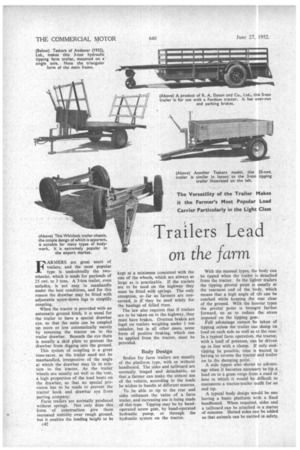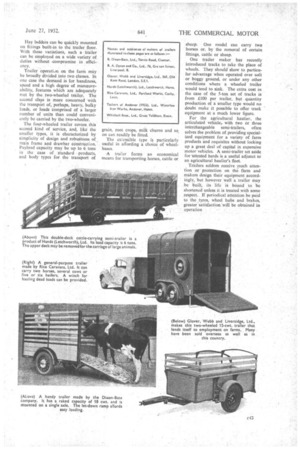Trailers Lead
Page 100

Page 101

If you've noticed an error in this article please click here to report it so we can fix it.
on the farm IFARMERS are great users of trailers, and the most popular type is undoubtedly the twowheeler, which is made for payloads of 25 cwt. to 3 tons. A 3-ton trailer, even unladen, is not easy to manhandle under the best conditions, and for this reason the drawbar may be fitted with adjustable screw-down legs to simplify coupling.
When the tractor is provided with an automatic ground hitch, it is usual for the trailer to have a special drawbar eye, so that the units can be coupled up more or less automatically merely by reversing the tractor on to the trailer drawbar. Beneath the eye there is usually a skid plate to prevent the drawbar from digging into the ground.
This system of coupling is a great time-saver, as the trailer need not be manhandled, irrespective of the angle at which the drawbar may lie in relation to the tractor. As the trailer wheels are usually set well to the rear, a high proportion of the load bears on the drawbar, so that no special provision has to be made to prevent the tractor hook and drawbar eye from parting company.
Farm trailers are normally produced without springs. Not only does this form of construction give them increased stability over rough ground, but it enables the loading height to be c42 kept at a minimum consistent with the size of the wheels, which are always as large as is practicable. If the trailers are to be used on the highway they must be fitted with springs. The only exception, so far as farmers are concerned, is if they be used solely for the haulage of felled trees.
The law also requires that if trailers are to be taken on to the highway, they must have brakes. Overrun brakes are legal on trailers weighing under 1 ton unladen, but in all other cases, some form of positive braking, which can be applied from the tractor, must be provided.
Body Design Bodies for farm trailers are usually of the platform type, with or without headboard. The sides and tailboard are normally hinged and detachable, so that.a farmer can make the utmost use of the vehicle, according to the loads he wishes to handle at different seasons.
To be able to tip to the rear and sides enhances the value of a farm trailer, and increasing use is being made of this type. Tipping may be by handoperated screw gear, by hand-operated hydraulic pump, or through the hydraulic system on the tractor.
With the manual types, the body can be tipped when the trailer is detached from the tractor. In the lighter trailers the tipping pivotal point is usually at the rearmost end of the body, which means that a high angle of tilt can be reached while keeping the rear clear of the ground. With the heavier types the pivotal point is brought farther forward, so as to reduce the stress imposed on the tipping gear.
Full advantage cannot be taken of tipping unless the trailer can dump its load on each side as well as at the rear. In a typical farm operation, the tractor, with a load of potatoes, can be driven up in line with a clamp. If only endtipping be possible, time is wasted in having to reverse the tractor and trailer on to the dumping point.
A side tipper also shows to advantage when it becomes necessary to tip a load on to a grass verge from a road or lane in which it would be difficult to manceuvre a tractor-trailer outfit for an end tip.
A typical body design would be one ' having a basic platform with a fixed headboard. When required, sides and a tailboard can be attached in a matter of minutes. Slatted sides can be added so that animals can be carried in safety. Hay ladders can be quickly mounted on fittings built-in to the trailer floor. With these variations, such a trailer can be employed on a wide variety of duties without -compromise in efficiency.
Trailer operation on the faun may be broadly divided into two classes. In one case the demand is for handiness, speed and a high degree of manceuvrability, features which are adequately met by the two-wheeled trailer. The second clap is more concerned with the transport of, perhaps, heavy, bulky loads, or loads comprised of a larger number of units than could conveniently be carried by the two-wheeler.
The four-wheeled trailer covers this second kind of service, and, like the smaller types, it is characterized by simplicity of design and robustness of main frame and drawbar cc:instruction. Payload capacity may be up to 6 tons in the case of standard products, and body types for the transport of
grain, root crops, milk churns and so on can readily be fitted.
The extensible type is particularly useful in affording a choice of wheelbases, A trailer forms an economical means for transporting horses, cattle or sheep. One model can carry two horses or, by the removal of certain fittings, cattle or sheep.
One trailer maker has recently introduced tracks to take the place of wheels. They should' show to particular advantage when operated over soft or boggy ground, or under any other conditions where a wheeled trailer would tend to sink. The extra cost in the case of the 5-ton set of tracks is from £100 per trailer, but quantity production of a smaller type would no doubt make it possible to offer track equipment at a much lower figure.
For the agricultural haulier, the articulated vehicle, with two or three interchangeable semi-trailers, often solves the problem of providing specialized equipment for a variety of farm products and requisites without locking up a great deal of capital in expensive motor vehicles. A semi-trailer set aside for —attested herds is a useful adjunct to an agricultural haulier's fleet.
Trailers seldom receive much attention or protection on the farm and makers design their equipment accordingly, but however well a trailer may be built, its life is bound to 'be shortened unless it is treated with some respect. If periodical attention be paid to the ,tyres, wheel hubs and brakes, greater satisfaction will be obtained in operation
















































































































































